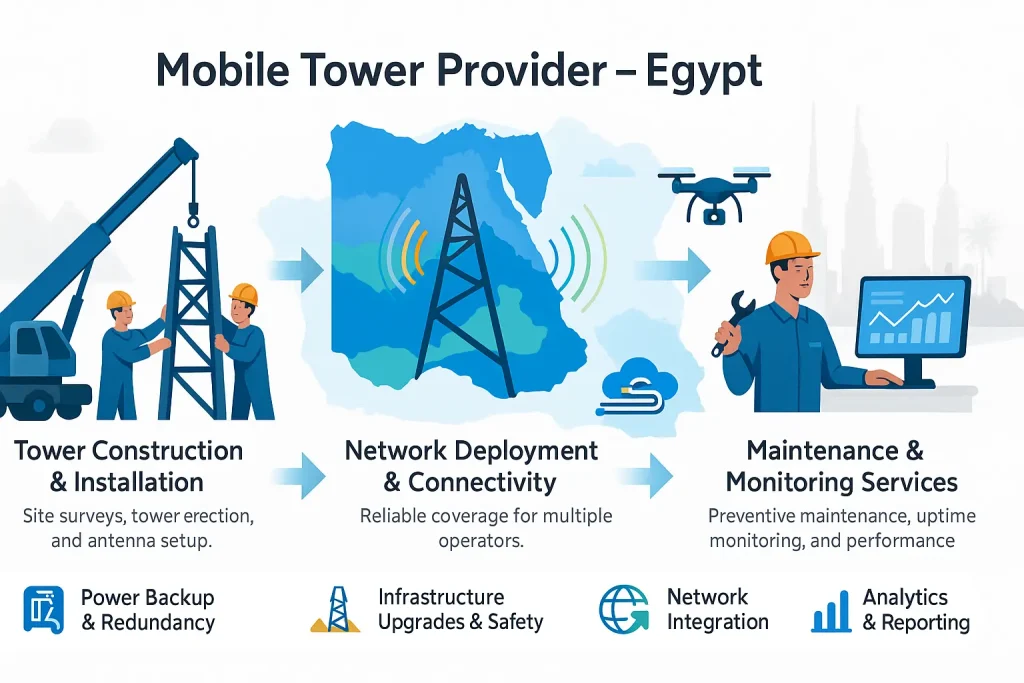Mobile Tower Providers in Egypt: Enhancing Network Reach
2025-10-25
A professional mobile tower provider in Egypt is a critical partner in the nation's digital transformation. Egypt is a major economic hub. It connects the Middle East and Africa. It has a large, tech-savvy population of over 100 million people. This creates an immense demand for high-quality mobile data. The government's "Digital Egypt" initiative and the recent launch of 5G services are fueling a massive need for new network infrastructure. This article explores the key mobile tower providers in Egypt. It details the market drivers and the opportunities for enhancing network reach.

The Key Drivers for Network Expansion in Egypt
The demand for new mobile towers in Egypt is accelerating. This growth is not from a single cause. It is a convergence of government strategy, new technology, and changing consumer behavior.
Egypt's Vision 2030 and "Digital Egypt"
The Egyptian government is the primary driver of this transformation. "Digital Egypt" is a core part of Egypt's Vision 2030. This national strategy aims to build a knowledge-based economy. It focuses on digital inclusion and transforming government services. The Ministry of Communications and Information Technology (MCIT) is investing heavily. It is upgrading the country's digital infrastructure. This top-down push creates a clear and urgent need for more mobile towers.
The Commercial Launch of 5G
The most significant driver is the 5G rollout. In late 2024, the National Telecom Regulatory Authority (NTRA) granted 5G licenses. All four major operators secured spectrum. By mid-2025, operators like Vodafone Egypt and Orange Egypt had launched commercial 5G services. 5G technology requires a much denser network than 4G. Its high-speed signals have a shorter range. This means operators must build many new sites. This "network densification" is driving a new wave of tower construction.
Soaring Data Consumption
Data consumption in Egypt is rising rapidly. The population is young and digitally active. The use of video streaming, online gaming, and social media is high. Fintech and super-apps are also booming. Mobile-based financial services require a stable data connection. This massive data usage puts a strain on 4G networks. Operators must expand capacity. A mobile tower provider in Egypt is essential to build the new sites that add this capacity.
The Telecom Market Structure in Egypt
Egypt's telecom market is mature and highly competitive. It is dominated by four major Mobile Network Operators (MNOs).
The Four Major Mobile Network Operators
These four MNOs are the primary customers for tower infrastructure.
- Vodafone Egypt: A leading player with a huge subscriber base. The company launched an extensive 5G network in 2025. Its initial rollout covered over 2,000 sites.
- Orange Egypt: Another major competitor. Orange also launched its 5G services in 2025. It is focusing on high-traffic zones.
- e& Egypt (formerly Etisalat Misr): A key innovator in the market. e& is also aggressively upgrading its network for 5G readiness.
- Telecom Egypt (WE): The state-owned incumbent. Telecom Egypt was the first to acquire a 5G license. It is rapidly building its mobile network to compete.
The Shift to the Independent TowerCo Model
Historically, these operators built, owned, and managed their own towers. This is the "operator-owned" model. This model is capital-intensive. It forces operators to spend money on concrete and steel.
The market is now shifting to the independent TowerCo model. In this model, operators sell their passive tower assets to a neutral third party. This third party is a mobile tower provider, or "TowerCo." The TowerCo then leases space on the tower back to the operator. It can also lease space to the other three operators. This sharing model is a global trend. It is efficient. It reduces costs for operators. It also frees up their capital. They can then invest in 5G spectrum and active equipment.
Key Mobile Tower Providers in Egypt
The TowerCo market in Egypt is new and dynamic. The NTRA has granted licenses to independent companies. This is fostering a new ecosystem of infrastructure providers.
IHS Towers
IHS Towers is a major global infrastructure provider. It has a significant presence in Africa, Latin America, and the Middle East. IHS Towers entered the Egyptian market through a joint venture. The company received a license to build and lease thousands of new towers. Its entry is a significant development. It brings massive international expertise and capital. This will help accelerate the 5G rollout.
Other Licensed Tower Companies
Other companies are also active in the market. HOI-MEA was one of the first companies to receive a TowerCo license in Egypt. It has been building shared, build-to-suit sites for operators. These providers are crucial. They build the neutral-host infrastructure that all operators can share. This speeds up network expansion.
Specialized Contractors and Manufacturers
Beyond the large TowerCos, there is a network of specialized providers. These companies offer key services. This includes tower manufacturing and fabrication. It includes civil works and site construction. It also includes tower installation and technical services. These local and regional contractors are essential partners. They are the ones who physically build and upgrade the sites.
The Technical Challenges of Enhancing Network Reach
A mobile tower provider in Egypt faces several key challenges. These hurdles must be overcome to meet the goals of Digital Egypt.
Urban Densification in Crowded Cities
Cities like Cairo and Alexandria are among the most densely populated in the world. Finding space for new macro towers is extremely difficult. The 5G rollout requires network densification. This means providers must use creative solutions.
- Rooftop Sites: Most new urban sites are on rooftops. This requires agreements with building owners.
- Small Cells: Operators are deploying small cells. These are low-power nodes. They can be placed on streetlights, utility poles, and building walls.
- Stealth Towers: In historic or aesthetic areas, "stealth" towers are needed. These are towers disguised as palm trees, flagpoles, or other structures.
Extending Coverage to New Developments
Egypt is building new cities. The New Administrative Capital is a massive smart city project. These new developments are being built from scratch. They require a complete telecommunications infrastructure. Tower providers are working to build 5G-ready networks in these new zones. This is a major construction opportunity.
Powering the Network
A reliable power source is a major challenge for tower sites. Many sites in Egypt face an unstable electricity grid. Remote sites may have no grid connection at all. Towers must have 24/7 power. This is traditionally solved with diesel generators. This is expensive, noisy, and bad for the environment. Tower providers are now deploying hybrid power solutions. This includes solar panels and battery storage. These green energy solutions reduce operational costs.
Egypt's Telecom Growth in a Global Context
Egypt's telecom expansion is a key part of a global telecom regional expansion. Comparing its journey to other nations provides valuable context.
Parallels with Other African Giants
Egypt is one of Africa's largest markets. Its challenges are shared by other regional leaders. Nigeria, for example, is also a massive, mobile-first economy. The demand for a cell tower near Nigeria is driven by similar factors. These include a large population and high data demand.
Kenya is another key comparator. It is East Africa's tech hub. The deployment of a 5G tower in Kenya is also a national priority. Both nations see 5G as a way to power their digital economies. As these networks grow, maintenance becomes vital. The need for cell tower maintenance in Nairobi reflects the same operational needs as in Cairo.
Learning from Middle Eastern Neighbors
Egypt's market is closely linked to the Middle East. The push for 5G and smart cities mirrors goals in the Gulf. The UAE has built a world-class network. The infrastructure for a telecommunication tower in Dubai is a benchmark for urban density.
Saudi Arabia's Vision 2030 is similar to Egypt's. This has driven a huge need for network upgrades. It also created a massive market for tower maintenance in Saudi Arabia. Finding a local tower company near Arabi is essential for all operators in that region. Egypt is part of this same competitive landscape.
Contrasting with Asian and American Markets
The scale of Egypt's national build-out has parallels in Asia. The market for telecommunication towers in India is vast. It involves connecting over a billion people. The logistical challenge of telecom tower installation in Indonesia across thousands of islands is immense.
These large-scale projects are also seen in the Americas. The requirement for communication tower construction in Brazil is to cover a continent-sized country. This is a different challenge from the dense urban rollout. The 5G tower installation in New York is a model of pure densification. Egypt's strategy must combine both. It must densify its cities and expand coverage to new lands. This strategy is a form of state-guided regional development.
Opportunities for Tower Providers in Egypt
The Egyptian market is full of opportunities for a skilled mobile tower provider. The 5G rollout is just beginning.
Build-to-Suit (BTS) for 5G
The most immediate opportunity is "Build-to-Suit" (BTS). This is where an operator gives a TowerCo the specifications for a new 5G site. The TowerCo then builds that site. It builds it with the operator as the anchor tenant. The TowerCo can then add the other three operators as tenants. This is a long-term, stable revenue model.
Acquisition of Operator-Owned Towers
A large opportunity exists in "Sale-and-Leaseback" (SLB) deals. The four operators in Egypt still own thousands of towers. As they need capital for 5G, they will look to sell these tower portfolios. An independent mobile tower provider can buy these assets. They then lease them back to the operator. This provides a huge injection of capital for the operator. It also instantly gives the TowerCo a large, mature portfolio.
Upgrading and Fiberization
The 5G rollout requires more than just new towers. Existing towers must be upgraded. They may need structural strengthening. This is to handle the weight of new 5G antennas. Most importantly, they need fiber backhaul. Many sites still use microwave links. Tower providers can offer "fiber-to-the-tower" (FTTT) services. This is a critical upgrade.
In-Building Solutions (IBS)
The demand for in-building coverage is a major growth area. A mobile tower provider in Egypt can specialize in these systems. This includes deploying Distributed Antenna Systems (DAS). These systems are needed in:
- Airports
- Shopping Malls
- Hospitals
- Corporate High-Rises
- New smart city buildings
Conclusion
The role of a mobile tower provider in Egypt has never been more important. These companies are the builders of "Digital Egypt." They are moving beyond being simple steel providers. They are becoming sophisticated infrastructure partners. They manage power, fiber, and complex electronics. They are essential for the 5G rollout. They help operators expand their reach. They do this by building new sites. They also do it by making the network more efficient through sharing. The demand for data and connectivity in Egypt is strong. This ensures a long-term, sustainable growth path for tower providers.

Hey, I’m Chunjian Shu
"X.Y. Tower: Reliable, innovative solutions for high-quality towers and electrical equipment with professional service.
